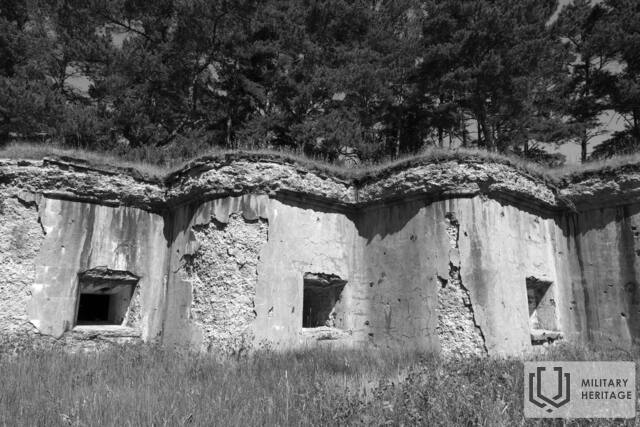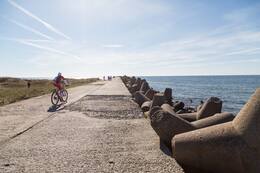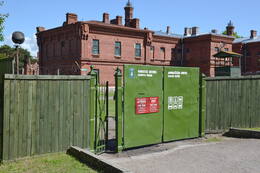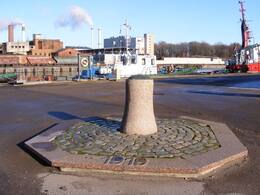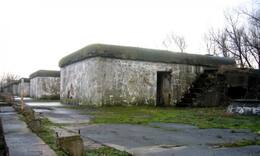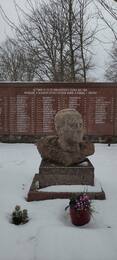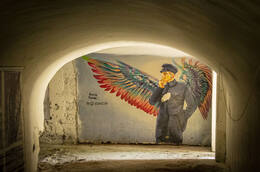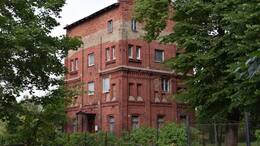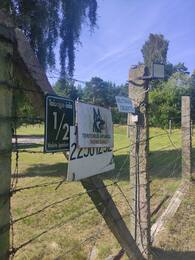Liepāja Sea Fortress I World War I
The fortress was built in the late 19th, early 20th centuries to protect the Liepāja Naval Base in the event of a potential enemy attack.
The fortification system, which included, for example, the Redan and the Northern Fort, surrounded the entire city. Partially washed into the sea, the Northern Forts can be dangerous to visit.
More information sources
Liepāja's history in twists and turns: Liepāja Fortress (liepajasvesture.blogspot.com)
Related objects
North Pier and Battery No.3 in Karosta
The longest pier in Latvia - the Northern Pier - was built at the end of the 19th century as a very important part of the Liepaja Sea Fortress and military port. The length of the pier is 1800 metres, the width - 7.35 metres.
The Northern Pier is one of the first port structures of Emperor Alexander III, built between 1890 and 1892 before the excavation of the Karosta Canal. Together with the North Breakwater, the South Breakwater and the South Pier, the pier formed the outpost of Liepaja.
Liepaja Fortress Battery No 3 was located next to the North Pier of the Karosta and was planned to be the largest in terms of armament. Platforms were built for four 6-inch (152 mm) guns of the 1892 model of the Canet system, five 11-inch (280 mm) guns of the 1887 model and two 57 mm Nordenfeld anti-tank guns, as well as 18 9-inch (229 mm) guns and mortars.
Today, Battery 3 is most affected by the prevailing south-north sea current, which creates a whirlpool effect behind the North Pier, resulting in the washouts of the gun platform foundations.
The North Pier protects the Liepaja harbour area from North Westerly winds. It is a favourite place for residents and visitors to Liepaja to watch sunsets, fish and watch the sea in different weather conditions. Especially spectacular during storms.
There is ample parking at the North Pier. There are also restrooms and a café with a unique sea view.
Berth of the ship "Saratov" in Liepaja
The berth of the "Saratov" is located in Liepaja, at 59 Old Harbour, near the boat docks.
Built in 1888 in Copenhagen by the shipyard Buvmeistar & Wain under the name "Leopold II", in 1911 it was bought by the joint-stock company Russian North-West Shipping and renamed "Saratov", with the Latvian Aleksandrs Remess becoming the ship's captain.
In May 1915, when Liepaja was occupied by German troops, the Saratov was in a damaged state in the harbour.
On 10 January 1919, the steamship Saratov was taken over by the Latvian Provisional Government. From April to July 1919, after the "16 April coup d'état", the Provisional Government headed by K. Ulmanis was on board the Saratov and was forced to take refuge under the protection of the Allied fleet.
On 8 July 1919, after the delivery of the Provisional Government of K. Ulmanis to Riga, the steamers were used for traffic between Riga, Ventspils and Liepaja.
Under the terms of the Peace Treaty of 11 August 1920 between Latvia and Soviet Russia, the steamship Saratov had to be returned to the Soviet side. On 2 January 1923, the steamship was handed over to a Soviet Russian representative. On 15 January 1923, the steamship "Saratov" was wrecked off Akmenrags.
In 1936 the Latvian Maritime Department sold the wreck to a company, which scrapped it and handed it over to the Liepaja Cloth Factory.
Liepaja Fortress Battery No 6
The 6th Battery, which is the best preserved fortification structure today, was planned to protect the coast of Liepaja Fortress south of the Trade Canal. The battery was to house four 6-inch (152 mm) guns of the 1892 model of the Canet system, eight 11-inch (280 mm) guns of the 1887 model, nine mortars of various calibres and two 57 mm Nordenfeld anti-tank guns. At the beginning of the First World War, after the fortress had already been dismantled, Battery 6 still contained the armament used in April 1915, when the German Navy attempted to land a landing at the South Pier.
In the early 1920s, the construction of the Olympia Stadium, which can still be seen today, began on the battery site. The fortification ditch dug at the southern end of the battery is today included in the Liepāja Seafront Park.
Monument to the dead fishermen and sailors and US airmen
250 metres south-west of Battery 6 is the Monument to Fishermen and Sailors, with a plaque to the US Navy PB4Y-2 Privateer scout plane shot down off Liepaja on 8 April 1950. The aircraft, nicknamed Turbulent Turtle, was part of Patrol Squadron 26 and took off from Wiesbaden airfield in the early hours of 8 April and, via Copenhagen, set off on a surveillance and possibly radio reconnaissance mission. According to the order, the aircraft could not approach closer than 20 nautical miles to the Kurland coast, but for some unknown reason it flew into the USSR's self-defined 12 nautical mile zone. Two La-11s of the Soviet 30th Guards Fighter Regiment intercepted and shot down the unarmed reconnaissance aircraft. The fate of the 10-strong crew of the downed aircraft is not known with certainty; there is conflicting information that all were killed or, alternatively, that some of the pilots survived and ended up in prisoner-of-war camps.
The crew:
AT1 Frank L. Beckman
AL3 Joseph J. Bourassa
ENS Tommy L. Burgess
AD 1 Joseph H. Danens
LT John H. Fette
CT3 Edward J. Purcell
LTJG Robert D. Reynolds
AN Joseph N. Rinnier
LT Howard W. Seeschaf
AD 1 Jack W. Thomas
Liepaja Fortress South Fort and monument to N. Dedaev, commander of the 67th Rifle Division of the Red Army
The South Fort of Liepaja Fortress is located in the south-western part of Liepaja, between Klaipėda Street and the beach.
A fort was planned to protect the port of Emperor Alexander III from the south, two kilometres from the southern border of the city. The fort was to be located between Liepāja Lake and the sea, west of the outlet of the Thunder River, reinforcing the reinforced concrete fortifications with a moat. Although the fortifications were almost completely finished, the armaments had not been deployed. The constructed cellars were used as storage facilities both during the First World War and during the Second World War. In the 1920s and 1930s, various factories were located in the fortification area. Unlike the Middle Fort and Ravelin, the South Fort never took part in the war, because in all the wars the invaders besieged the eastern shore of Lake Liepāja and tried to invade Liepāja between Lakes Tosmare and Liepāja.
To the north of the South Fort is Liepāja's largest cemetery, the Central Cemetery. In the southern part of the cemetery there is a Red Army cemetery where Soviet soldiers who died in the vicinity of Liepāja are reburied, including the commander of the 67th Rifle Division, Major General Nikolai Dedaev, who led the defence of Liepāja in June 1941.
The Redan, Karosta
Redans, or Redana Fort, is located in Karosta, 14. novembra Street, about 1.5 km from the Northern Forts, in the nature reserve "Tosmare".
Historically, redans were elements of fortifications where longer sections of fortress walls were divided into shorter sections by building V-shaped positions facing the enemy, which allowed for better protection of the fortification wall. Karostas Redan is a late 19th century Liepaja Sea Fortress, projecting towards Lake Tosmare. As the fortress lost its fortress role, the fortifications and forts around it were partially blown up and rendered unusable. However, Redan remained almost intact.
In November 1919, after the failure at Riga, Pavel-Bermont Avalov's forces launched an intensive attack on Liepaja. The battle was also fought at Redan, where 80 soldiers of the Liepaja Military Port Commandant's Office under the command of Lieutenant Commander Radzins fought. In a swift attack on 14 November, the Bermontians managed to take Redan. This was followed by a counter-attack by Latvian troops and Redan was retaken.
In June, July and August, a knowledgeable guide will be waiting at Redan every day from 11.00-17.00, ready to tell you more about Liepāja Fortress and the historical events in the Karosta.
Pigeon post sea station in Karosta
The former naval pigeon station No.2 - actually a breeding station - is located in Karosta, Pulkveža Brieža iela 6. It was built between 1899 and 1900 and was intended to house about 450 carrier pigeons - winged soldiers. In later years, the building was converted into apartments, so that only the red brick volume of the building remains. The other post pigeon station, No 1, which has not survived, was intended for the use of 750 ground troops and was located at the northern end of Atmodas Boulevard.
The carrier pigeons were a simple, fast and reliable way to ensure communication between the shore and ships at sea. Although the radio telegraph, as a modern communication device, was already widely used at that time, the use of pigeons was considered safer - an enemy could only intercept a message by intercepting the carrier pigeon itself. The carrier pigeons moved at an average speed of 60 km per hour, but in favourable wind conditions they could move at speeds of up to 100 km per hour. Pigeons had to be specially prepared and trained, so handling them required care and patience. The homing pigeon's communication worked through the birds' ability to return to their home cage. When the bird was transferred to another location - a pigeon station, release and release point - and released with a message capsule, the little messenger returned to its home cage. In order to ensure communication between the two pigeon stations, it was necessary to keep a certain number of birds in each, which had grown up in the correspondent's communication, or carrier pigeon, station. Each year the pigeons were involved in various manoeuvres and competitions. Also after Latvia's independence, from 1920 to 1940, an army carrier pigeon station was located in Liepāja for the Latvian Army's Courland Division, which was able to communicate with both Riga and Daugavpils. During the inter-war period, stray communication pigeons from Germany, Poland, Lithuania, Finland and Estonia also wandered into Latvian territory. Pigeons from Latvia were also suddenly found in neighbouring countries.
The building has been rebuilt several times over the years and is now a residential building. But the distinctive shape of the building, made of the red bricks characteristic of the old buildings of the Karosta, is still clearly visible from the outside.
Liepāja Coastal Artillery Battery No. 2
Among the many objects of the Liepāja Naval Museum, the Liepāja Coastal Artillery Battery No. 2 is still the most mysterious place in Liepāja. Battery No. 2 was invariably equipped with ammunition depots for the troops of various existing powers.
Liepāja Fortress Battery No. 2 was built further from the coastline and was protected by a high fortification wall. The battery was armed with 16 11-inch (280 mm) mortars of the 1877 model. After the fortress was dismantled, ammunition depots were set up here. Due to the explosive hazard, the territory was closed to the public for 130 years, a guarded area, but now an exhibition has been set up here about the activities of the 1st Courland Division Headquarters in 1919-1940, as well as photographic evidence of the 1st Liepāja Infantry Regiment, the 2nd Ventspils Infantry Regiment and the Courland Artillery Regiment.
Liepāja Northern Fort and Battery Nr.1 in Karosta
The Northern Forts are the best known and visually most impressive part of the Liepāja Fortress. Built by the Russian tsarist army in the late 19th century, their historical name is Fortress Battery No 1.
In November 1908, less than 10 years after its construction, the Liepāja Fortress ceased to operate, because its construction was acknowledged as a strategic mistake. Some of the cannons were dismantled and taken to the Kaunas Fortress in Lithuania, while others were remelted. Fortification structures were detonated twice in an attempt to destroy the fortifications. Elements surviving to the present day include artillery batteries not fully destroyed in the explosions and underground structures. Just like the Karosta, the Northern Forts were a closed military territory during the Soviet occupation. Visitors to the Northern Forts should be very careful. As in other places on the Latvian coast, the steep shore of the Baltic Sea in the Karosta is dangerous due to potential coastal landslides. Therefore, it is not allowed to walk under the ruins of the forts.
In the northern part of the fortress was located one of the four coastal defence batteries, Battery No.1. The battery was to house six 6-inch (152 mm) guns of the 1892 model of the Canet system, six 11-inch (280 mm) guns of the 1887 model and two 57 mm Nordenfeld anti-ship guns. Only the guns of the Canet system had a long enough firing range to withstand possible shelling by the German Navy. Thus, at the time of the liquidation of the fortress, the armament was only partially installed.
Related stories
Soviet air raids on the Liepāja suburb in October and December 1944
At the end of World War II, the German forces in Courland were able to successfully defend themselves for seven months, as the German Navy maintained combat capability until the end of World War II and supplied Army Group North and later Army Group Courland. The main port was Liepaja, through which 80% of all cargo was delivered and shipped. Liepaja thus became an important target for the Soviet Baltic Navy and long-range aviation.
Wounding of Major General N. Dedayevs at the Liepāja Fortress, Vidus Fort
In June 1941, the successful attack of the German army had reached Liepaja, when Liepaja was attacked by the 291st Infantry Division of the German Armored Forces. When hostilities between Nazi Germany and the Soviet Union began in June 1941, the Liepaja garrison of the Soviet Army consisted of troops from the Liepaja naval base of the Navy and the Red Army. During these battles Major General N.Dedaev was mortally wounded
Battle of Redan in November 1919
Donāts Pudulis was a sergeant of Liepaja Military Port Commandant's Office, who received the Order of the Battle of the Battle of the Bulge for bravery and valour on 14 November 1919, when after the enemy attacked Redāns Fort, he took over the command of the commandant's company from the mortally wounded Lieutenant Commander Robert Radziņš and in a swift counterattack drove the enemy out of the fort, taking 8 prisoners and 2 working machine guns. His life up to the Battle of Liepaja is interesting. He volunteered for the Siberian Rifle Regiment in 1911 at the age of 16. In 1914 he took part in the battles against the German army at Warsaw, Lodz and elsewhere on the Polish front, and later in the battles against the Austrian army. In 1915 he sailed to France via Vladivostok as part of the Russian Expeditionary Corps and fought for 4 months at Verdun. At the beginning of 1917 he joined the Latvian Rifle Regiments, and on 7 April 1919 - the Latvian Armed Forces in Liepaja.
Winged warriors
The use of carrier pigeons or carrier pigeons was a widely used means of communication in the early 20th century.
Karosta – the landing site of a German He-111 on the beach of Liepāja in 1939
On 11 September 1939, a German Henkel He-111 bomber was raiding Polish cities when it went off course at night and made an emergency landing on Liepāja beach. This event is recounted in the memoirs of Vilis Zobens, a Liepaja resident and a liaison company officer of the Kurzeme Division. The landing site is not marked in nature. The approximate coordinates are N 56.59368° E 21.01598° - on the beach near the Northern Forts.
Description of the combat activity of Vilis Narkevics on 6 November 1919
Description of the combat activity of the commander of the detachment, Lieutenant Commander Julius Rosenthal Vilis Narkevics, 3 November 1921
Reasons for awarding the award to Commander of the Armoured Train A.Klestrov
After successfully repelling an enemy attack, the commander of the armed train A.Klestrov falls and Colonel Danker issued the grounds for the award




